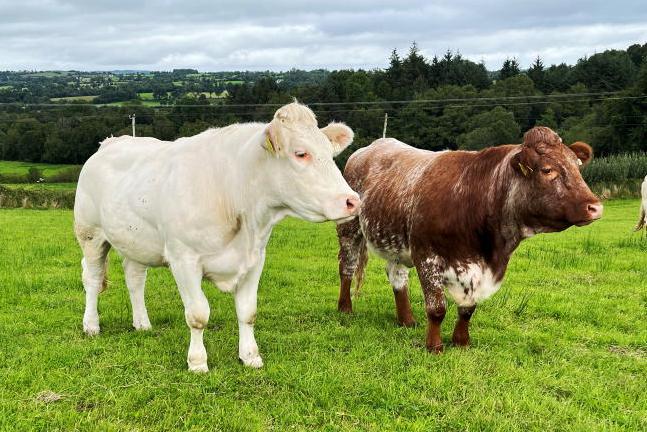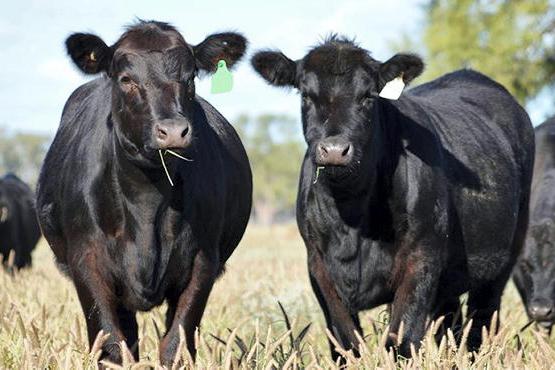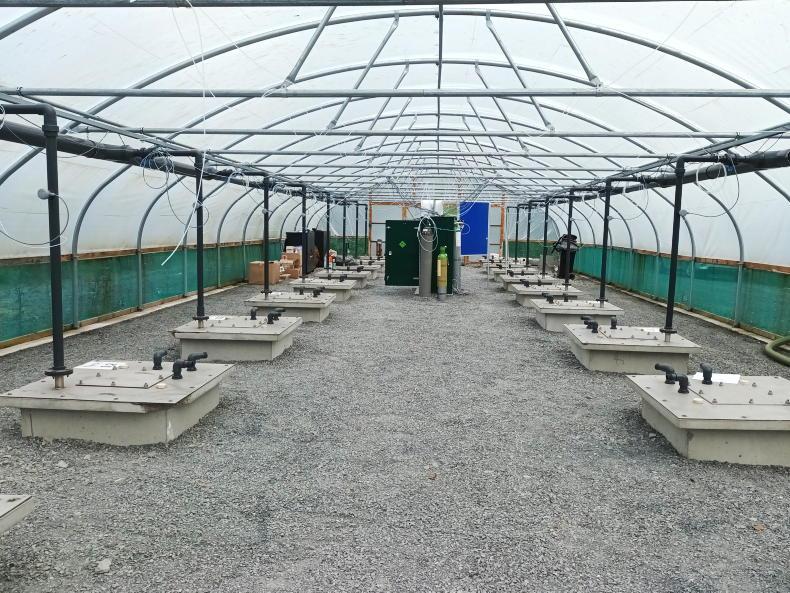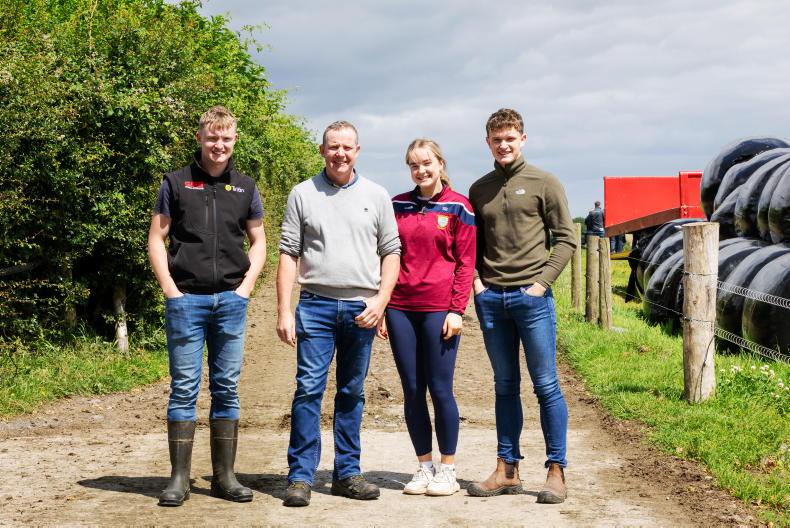The Food Vision dairy group was established by the Minister for Agriculture Charlie McConalogue in January, whose remit was to come up with ways of reducing greenhouse gas emissions from dairy farms.
The group was made up of farming organisation and industry representatives and chaired by the retired head of Teagasc, Prof Gerry Boyle.
The group’s final report was published last week in a low key affair. The document listed five key actions that dairy farmers can take to reduce greenhouse gas emissions.
The report recommends a reduction in chemical nitrogen use of between 27% and 30% by the end of 2030 with an interim target of 22% to 25% by 2025.
The reduction is based on actual fertiliser used with 2018 the base year. In that year, a total of 408,000t of nitrogen was used and dairy farmers are said to use half of this. So the target by the end of 2030 is for dairy farmers to use between 143,000t and 149,000t of chemical nitrogen. To put this in context, fertiliser use among dairy farmers this year is expected to be around 162,000t, 19% lower than last year.
If achieved, the reduction in nitrogen will reduce emissions by 0.37 Mt CO2e by the end of 2030. However, the implications at farm level are huge, with a Teagasc report saying that a 30% reduction in nitrogen would reduce profit per hectare by 15% if cow numbers were kept constant and the reduction in grass growth was replaced by purchased feed.
The report says Teagasc needs to repeat this study taking into account mitigating factors such as clover, low emission slurry spreading, etc.
Replace CAN with protected urea by end of 2025
CAN-based nitrogen fertiliser releases nitrous oxide emissions from soil which is a potent greenhouse gas.
The report suggests that 140,000t of nitrogen used on dairy farms will be in the form of protected urea, which will reduce emissions by 0.33 Mt CO2e per year.
The report says the main obstacle to this is the availability of protected urea. Separately, compound fertilisers containing relatively low levels of nitrogen, such as 18:6:12 or 10:10:20 will still be considered sustainable fertilisers because of the form of nitrogen they come in.
It is expected that these nitrogen-based fertilisers will have similar nitrous oxide emissions factors to protected urea when research is concluded.
In terms of cost, protected urea is cheaper than CAN on a per kilo of N basis. The report suggests that Teagasc undertakes further research into why a small number of farms are experiencing problems with the efficacy of protected urea.
Use a feed additive to reduce methane emissions
Feed additives such as 3NOP have been proven to reduce methane emissions by 30% in cows fed an indoor diet with constant intake of the additive. This is more challenging in a grass-based scenario. The report suggests that feeding 3NOP to cows at grass twice per day at milking time will reduce emissions by 10%.
If 85% of spring-calving cows got this at milking time and if 80% of winter milk herds got 3NOP, as part of a TMR, emissions would reduce by 0.43 Mt CO2e.
The report goes on to say that if a long-acting 3NOP bolus could be developed by 2030, this would reduce emissions by a further 15% leading to a total reduction of 1 Mt CO2e by 2030.
The biggest obstacle here is cost, with the report suggesting that 3NOP can cost between €75 and €100 per cow per year. While feeding it as part of a TMR or concentrate mix is relatively straightforward, if a bolus is to be fed that requires additional labour.
Breeding strategies to reduce methane
The report suggests that breeding can reduce methane emissions by 0.3Mt to 0.4Mt CO2e by the end of 2030.
There are two aspects to breeding; one is the impact of improved breeding strategies on carbon footprint, such as better fertility, reduced number of replacements, etc.
A new carbon sub-index is set to be incorporated into the EBI later this year.
The report considers these to be enabling factors and their contribution will be eroded if dairy cow numbers continue to increase.
Breeding to reduce methane emissions is seen as having a direct impact on reducing methane emissions but this low-methane trait won’t be introduced for another one to two years and the full benefits won’t be seen until after 2030.
The main obstacles here are the costs of genotyping the national herd and the ongoing costs of genotyping dairy replacements. The report says it costs €15 per animal for it to be genotyped.
Voluntary exit/reduction scheme
This suggestion is for a scheme that rewards farmers who reduce or exit milk production for an agreed period.
The report states that the measure will only be successful if overall breeding ruminant numbers decrease.
A breeding ruminant is a cow or heifer of a dairy or beef breed.
The report says that for every 100,000 dairy cows removed, overall greenhouse gas emissions reduce by 0.45Mt CO2e.
Compensation is suggested at €590/cow per year for herds that fully exit dairy production and €970/cow per year for herds that reduce cow numbers but remain in dairy production.
The payment for reducing cow numbers is higher because the report says that the overhead or fixed costs would remain in a herd reduction scenario. Over a three-year period, the compensation per cow for a herd exiting production would be €1,770/cow and €2,910/cow for a herd reducing cow numbers.
These figures were derived by looking at the difference between dairy incomes and cattle rearing and tillage incomes in the National Farm Survey between the years 2019 and 2021.
The report states that the measure is indicative only and not a policy recommendation and, if implemented, will require significant funding.
Total reduction
The 25% cut to agricultural emissions, which was announced earlier this year, corresponds to a greenhouse gas reduction of 5.75 Mt CO2e for agriculture from 2018 levels.
As dairy is responsible for approximately 40% of emissions from agriculture, so it falls that it has to reduce emissions by 2.3Mt CO2e.
If measures one to four were implemented to their maximum the total reduction would be 2.1Mt, just shy of the target and before any voluntary reduction in cow numbers is factored in.
It’s very easy to fall into a trap and think that because this report sets out measures to more or less achieve the climate targets that it’s somewhat easy to achieve them.
Each of the measures involve some element of higher costs or lower production.
A 30% cut in nitrogen use is massive and has massive implications on profit, considering the vacuum of information on maintaining high clover swards.
The use of feed additives seems optimistic and at up to €100/cow per year who will pay for it?
Even the contribution of genetics is doubtful as a reduction is only possible where cow numbers are stable or reducing – effectively, a cap on production, ie produce the same but with less stock.
It is now up to the minister to decide what to do with the report. If the first four measures are enforced, it will be at massive cost to dairy farmers and the sector, in general.
This is on top of the substantial changes to CAP and the sweeping cuts to the upper limit on nitrates derogation, for which farmers were never consulted.
It''s clear that Government and EU ambition is to reduce emissions at the expense of food production. While not impacting on EU food security, it will have a disastrous impact on food availability in developing countries with the poorest hit hardest. That''s the trade-off with lowering environmental footprint.
The Food Vision dairy group was established by the Minister for Agriculture Charlie McConalogue in January, whose remit was to come up with ways of reducing greenhouse gas emissions from dairy farms.
The group was made up of farming organisation and industry representatives and chaired by the retired head of Teagasc, Prof Gerry Boyle.
The group’s final report was published last week in a low key affair. The document listed five key actions that dairy farmers can take to reduce greenhouse gas emissions.
The report recommends a reduction in chemical nitrogen use of between 27% and 30% by the end of 2030 with an interim target of 22% to 25% by 2025.
The reduction is based on actual fertiliser used with 2018 the base year. In that year, a total of 408,000t of nitrogen was used and dairy farmers are said to use half of this. So the target by the end of 2030 is for dairy farmers to use between 143,000t and 149,000t of chemical nitrogen. To put this in context, fertiliser use among dairy farmers this year is expected to be around 162,000t, 19% lower than last year.
If achieved, the reduction in nitrogen will reduce emissions by 0.37 Mt CO2e by the end of 2030. However, the implications at farm level are huge, with a Teagasc report saying that a 30% reduction in nitrogen would reduce profit per hectare by 15% if cow numbers were kept constant and the reduction in grass growth was replaced by purchased feed.
The report says Teagasc needs to repeat this study taking into account mitigating factors such as clover, low emission slurry spreading, etc.
Replace CAN with protected urea by end of 2025
CAN-based nitrogen fertiliser releases nitrous oxide emissions from soil which is a potent greenhouse gas.
The report suggests that 140,000t of nitrogen used on dairy farms will be in the form of protected urea, which will reduce emissions by 0.33 Mt CO2e per year.
The report says the main obstacle to this is the availability of protected urea. Separately, compound fertilisers containing relatively low levels of nitrogen, such as 18:6:12 or 10:10:20 will still be considered sustainable fertilisers because of the form of nitrogen they come in.
It is expected that these nitrogen-based fertilisers will have similar nitrous oxide emissions factors to protected urea when research is concluded.
In terms of cost, protected urea is cheaper than CAN on a per kilo of N basis. The report suggests that Teagasc undertakes further research into why a small number of farms are experiencing problems with the efficacy of protected urea.
Use a feed additive to reduce methane emissions
Feed additives such as 3NOP have been proven to reduce methane emissions by 30% in cows fed an indoor diet with constant intake of the additive. This is more challenging in a grass-based scenario. The report suggests that feeding 3NOP to cows at grass twice per day at milking time will reduce emissions by 10%.
If 85% of spring-calving cows got this at milking time and if 80% of winter milk herds got 3NOP, as part of a TMR, emissions would reduce by 0.43 Mt CO2e.
The report goes on to say that if a long-acting 3NOP bolus could be developed by 2030, this would reduce emissions by a further 15% leading to a total reduction of 1 Mt CO2e by 2030.
The biggest obstacle here is cost, with the report suggesting that 3NOP can cost between €75 and €100 per cow per year. While feeding it as part of a TMR or concentrate mix is relatively straightforward, if a bolus is to be fed that requires additional labour.
Breeding strategies to reduce methane
The report suggests that breeding can reduce methane emissions by 0.3Mt to 0.4Mt CO2e by the end of 2030.
There are two aspects to breeding; one is the impact of improved breeding strategies on carbon footprint, such as better fertility, reduced number of replacements, etc.
A new carbon sub-index is set to be incorporated into the EBI later this year.
The report considers these to be enabling factors and their contribution will be eroded if dairy cow numbers continue to increase.
Breeding to reduce methane emissions is seen as having a direct impact on reducing methane emissions but this low-methane trait won’t be introduced for another one to two years and the full benefits won’t be seen until after 2030.
The main obstacles here are the costs of genotyping the national herd and the ongoing costs of genotyping dairy replacements. The report says it costs €15 per animal for it to be genotyped.
Voluntary exit/reduction scheme
This suggestion is for a scheme that rewards farmers who reduce or exit milk production for an agreed period.
The report states that the measure will only be successful if overall breeding ruminant numbers decrease.
A breeding ruminant is a cow or heifer of a dairy or beef breed.
The report says that for every 100,000 dairy cows removed, overall greenhouse gas emissions reduce by 0.45Mt CO2e.
Compensation is suggested at €590/cow per year for herds that fully exit dairy production and €970/cow per year for herds that reduce cow numbers but remain in dairy production.
The payment for reducing cow numbers is higher because the report says that the overhead or fixed costs would remain in a herd reduction scenario. Over a three-year period, the compensation per cow for a herd exiting production would be €1,770/cow and €2,910/cow for a herd reducing cow numbers.
These figures were derived by looking at the difference between dairy incomes and cattle rearing and tillage incomes in the National Farm Survey between the years 2019 and 2021.
The report states that the measure is indicative only and not a policy recommendation and, if implemented, will require significant funding.
Total reduction
The 25% cut to agricultural emissions, which was announced earlier this year, corresponds to a greenhouse gas reduction of 5.75 Mt CO2e for agriculture from 2018 levels.
As dairy is responsible for approximately 40% of emissions from agriculture, so it falls that it has to reduce emissions by 2.3Mt CO2e.
If measures one to four were implemented to their maximum the total reduction would be 2.1Mt, just shy of the target and before any voluntary reduction in cow numbers is factored in.
It’s very easy to fall into a trap and think that because this report sets out measures to more or less achieve the climate targets that it’s somewhat easy to achieve them.
Each of the measures involve some element of higher costs or lower production.
A 30% cut in nitrogen use is massive and has massive implications on profit, considering the vacuum of information on maintaining high clover swards.
The use of feed additives seems optimistic and at up to €100/cow per year who will pay for it?
Even the contribution of genetics is doubtful as a reduction is only possible where cow numbers are stable or reducing – effectively, a cap on production, ie produce the same but with less stock.
It is now up to the minister to decide what to do with the report. If the first four measures are enforced, it will be at massive cost to dairy farmers and the sector, in general.
This is on top of the substantial changes to CAP and the sweeping cuts to the upper limit on nitrates derogation, for which farmers were never consulted.
It''s clear that Government and EU ambition is to reduce emissions at the expense of food production. While not impacting on EU food security, it will have a disastrous impact on food availability in developing countries with the poorest hit hardest. That''s the trade-off with lowering environmental footprint.










SHARING OPTIONS